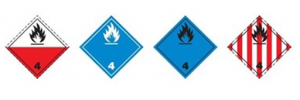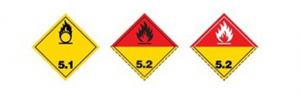IMO Classes for Dangerous Goods
The Carriage of dangerous goods and marine pollutants in sea-going ships is respectively regulated in the International Convention for the Safety of the Life at Sea (SOLAS) and the International Convention for the Prevention of pollution from Ships (MARPOL).
Relevant parts of both SOLAS and MARPOL have been worked out in great detail and are included in the International Maritime Dangerous Goods (IMDG) Code, thus making this Code the legal instrument for maritime transport of dangerous goods and marine pollutants. As of 1st January 2004, the IMDG Code will become a mandatory requirement.
Classification of dangerous goods
For all modes of transport (sea, air, rail, road and inland waterways) the classification (grouping) of dangerous goods, by type of risk involved, has been drawn up by the UNITED NATIONS Committee of Experts on the Transport of Dangerous Goods (UN).

Class 1. Explosives
Depending on the risk of mass explosion or fire causing projection

Class 2. Gases
Liquefied, compressed or refrigerated. Classified in: asphyxiating, oxidising, flammable or toxic.

Class 3. Flammable Liquid
Flammable liquids and insensitive explosive liquids. Example: Turpentine, gasoline, paints, varnishes, etc.

Class 4. Flammable Solid

Class 5. Organic Peroxides

Class 6. Toxic, Poison substances

Class 7. Radioactive Substances
They contain radionuclides. Eg uranium, plutonium, thorium.

Class 8. Corrosives
Destructive effect upon contact. Eg. Sulfuric acid, sodium hypochlorite.

Class 9. Miscelaneous
A material which presents a hazard during transportation but which does not meet the definition of any other hazard class.